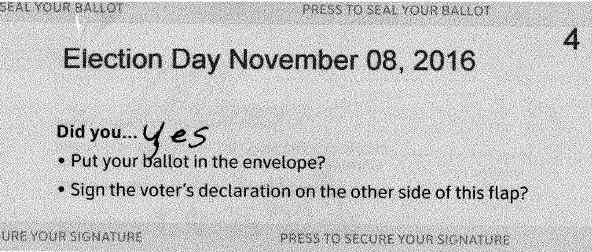Checklists to the rescue
We know that in every corner of the country, our amazing election officials are calmly, patiently, professionally working through the last tasks before the polls open on November 8 to get ready for the counting. We also know that your jobs are far from done when the returns are in.
Odds are good that there are dozens of checklists in place so you can make sure that things go smoothly. We have one more place you might think about using checklists–for the next election, of course: on forms for voters.
So, good luck on Election Day 2016. Be safe. And, may the margins of victory be wide!
Help voters succeed
Every county we know works hard to make sure that voters can fill out important election forms without mistakes. Whether it’s a voter registration update, vote-by-mail envelopes, the forms that go along with provisional ballots, or forms to let voters fix mistakes on a previous form, each of them has a process.
Tell voters what to do after they finish the form
Don’t just hope that voters have followed the instructions and gotten everything right. Put a checklist at the end of the form, where voters can’t miss it.
List actions to prevent the most frequent mistakes (and anything else that can be a problem). You don’t have to repeat all of the instructions. This is a reminder, not the full instruction.
Cover all the steps in the process. Nothing is too obvious to include, but the most important reminders are:
- Anything to be included
- Signatures
- Postage
- Deadlines
Talk directly to the voter. Make the checklist active, with each item in the list a question to the voter. Two ideas for how to write the checklist so it’s clear and simple are shown below.
Did you…
- Put your ballot in the envelope?
- Sign the form on the other side?
- Put 70¢ postage on the envelope?
OR
- Is your ballot inside
- Did you sign the form?
- Did you add 70¢ postage?
Checklists make a difference
When confronted with a pile of paperwork, it’s easy to forget a signature or even to put the ballot in the envelope. Adding a checklist can make the difference between a successfully completed form, and a lost vote.
Try it on your next form or letter. You might be rewarded with clear signs that voters noticed—and used—the checklist.

Shasta County officials have found several vote-by-mail ballot envelopes where voters have answered the question…right on the back of the envelope.

On other envelopes, it’s easy to tell that voters have seen the three options for returning their vote-by-mail ballot, because they’ve ticked the off as they considered them.
Resources
Field Guide Vol. 10 Creating forms that help voters take action
Field Guide Vol. 2 Writing instructions voters understand

